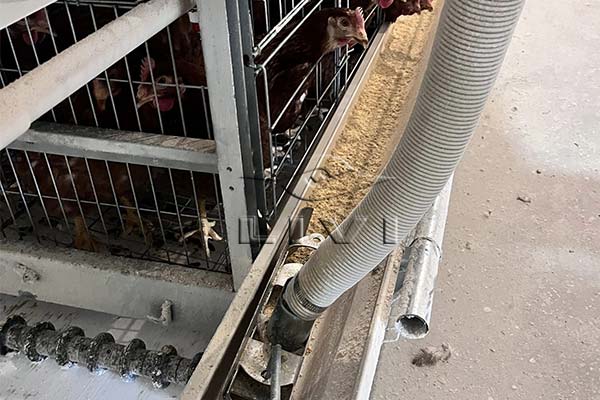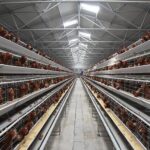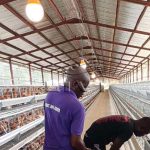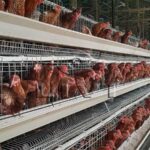Poultry farming in Ghana has grown into one of the most profitable agribusiness ventures, and modern technology is changing the way farmers manage large commercial flocks. One of the most effective systems for egg production is the battery cage system, which allows poultry farmers to keep thousands of birds in an organized, efficient, and hygienic environment.
If you are planning to raise 30,000 layer chickens in Ghana, investing in automatic poultry farm equipment—including cages, feeding, drinking, manure removal, and egg collection systems—can dramatically improve productivity and reduce labor costs. This article explores everything you need to know about setting up a 30,000-bird battery cage farm in Ghana, the required equipment, house design, budgeting, and return on investment.

What Is a Battery Cage System?
A battery cage system for layer chickens is a stacked arrangement of cages where birds are kept in compartments with feeders and nipple drinkers. The cages are designed to save space, improve biosecurity, reduce feed wastage, and increase egg collection efficiency.
Modern battery cage systems are often combined with automatic poultry farm equipment, which includes:
- Automatic feeding machines
- Nipple drinking lines with regulators
- Manure removal belts
- Optional egg collection belts
- Climate control and lighting systems
This setup is ideal for farmers in Ghana who want to run commercial poultry farms with 10,000, 20,000, or 30,000 layers.
Why Choose Battery Cages for Layer Chickens in Ghana?
There are several reasons Ghanaian farmers prefer battery cages over the traditional deep litter system:
- Higher Stocking Density – With battery cages, a farmer can keep up to three times more birds in the same house compared to floor systems. For a 30,000 layer poultry farm, this means reduced land and housing costs.
- Better Egg Quality – Eggs roll onto collection trays, minimizing cracks and contamination from manure.
- Reduced Feed Waste – The design of feeders in automatic systems ensures that feed spillage is minimized, saving significant costs in large flocks.
- Improved Hygiene – Manure belts remove droppings daily or weekly, reducing ammonia levels and disease risks.
- Ease of Management – Automatic poultry equipment reduces manual labor, making it easier to manage large flocks.

Types of Battery Cages for 30,000 Layers
When designing a 30,000-bird poultry farm in Ghana, you can choose between two main cage types:
1. A-Frame Battery Cage System
- Typically 3–4 tiers
- Birds per set: about 120–160
- Advantages: Good airflow, simple design, cost-effective
- Suitable for: Natural or curtain ventilation houses
2. H-Frame Battery Cage System
- 4–8 tiers possible
- Birds per set: about 200–240
- Advantages: Higher stocking density, efficient with full automation
- Suitable for: Tunnel-ventilated houses
For 30,000 birds, you would need around 188 sets of A-frame cages or 150 sets of H-frame cages, depending on the exact specifications from the supplier.

Poultry House Design for 30,000 Layers in Ghana
The design of the poultry house is critical for flock health and productivity. Ghana’s tropical climate requires careful attention to ventilation, temperature, and humidity control.
Option A: Open-Sided House with Curtains (A-Frame Cages)
- Width: 12–14 meters
- Length: 80–100 meters
- Ventilation: Natural airflow with curtains for rain protection
- Roof: Insulated sheets with wide overhangs and ridge vent
Option B: Tunnel Ventilation House (H-Frame Cages)
- Width: 14–16 meters
- Length: 70–90 meters
- Ventilation: Exhaust fans and cooling pads
- Suitable for: Fully automated systems with high stocking density
Most 30,000-layer poultry farms in Ghana are divided into two houses of 15,000 birds each. This makes management easier and reduces disease risks.

Essential Automatic Poultry Farm Equipment
To successfully manage 30,000 laying hens in cages, the following equipment is recommended:
- Battery Cages – Galvanized cages with anti-rust coating for long service life.
- Feeding System – Silos connected to automatic feed delivery lines, reducing labor and ensuring uniform feeding.
- Drinking System – Nipple drinkers (1 per 8–12 birds), pressure regulators, and medicators for clean water supply.
- Manure Removal System – Conveyor belts under each tier, transferring droppings to a trailer or composting site.
- Egg Collection System – Optional longitudinal belts and elevators for easy egg handling.
- Electrical Control – Panels, motors, gearboxes, and backup generators for reliable operation.
- Lighting System – LED lights with dimmers to manage laying cycles.
- Biosecurity Facilities – Fencing, footbaths, and disinfection areas to keep diseases out.
Utility Requirements for a 30,000-Layer Poultry Farm
A farm of this size requires reliable utilities:
- Power: 30–60 kW per house, with a standby generator.
- Water: 0.2–0.3 liters per bird daily, i.e., about 9,000 liters/day for 30,000 birds.
- Feed Storage: 3.3 tons/day feed demand; silos with 50–70 tons capacity recommended.
One of the biggest concerns for farmers planning a 30,000-layer poultry farm in Ghana is the overall investment cost. While large-scale, fully automated systems can easily exceed USD 400,000, many Ghanaian farmers prefer a cost-effective approach that balances automation with manual labor. By choosing semi-automatic poultry farm equipment and optimizing local construction, the total budget can be kept around USD 100,000.
Here is a practical breakdown:
- Battery cages with semi-automatic features: USD 2–3 per bird
→ For 30,000 birds = USD 60,000–90,000
(Includes galvanized cages, feeding troughs, nipple drinkers, and manure removal belts) - Basic egg collection system (optional): USD 0.5–1 per bird
→ For 30,000 birds = USD 15,000–20,000
(Farmers may also choose manual egg collection to save costs) - Ventilation and lighting: USD 0.3–0.5 per bird
→ For 30,000 birds = USD 9,000–15,000
(Natural ventilation with side curtains and ceiling fans instead of full tunnel ventilation) - Civil works (local poultry house construction): USD 0.5–1 per bird
→ For 30,000 birds = USD 15,000–30,000
(Using local materials, open-sided design, concrete floors, and metal roofing)

Total Estimated Investment:
USD 80,000 – 100,000 (excluding shipping and duties)
This budget-friendly approach makes it possible for Ghanaian farmers to set up a 30,000-layer battery cage farm without overspending, while still benefiting from the advantages of automatic poultry equipment such as reduced feed waste, better egg quality, and easier manure management.
Expected Returns from 30,000 Layers in Ghana
Profitability depends on egg prices, feed costs, and flock performance.
- Egg production: At 90% lay, 27,000 eggs/day
- Feed consumption: 110 g/bird/day → 3.3 tons/day
- Feed cost: Local rates vary; often the largest expense (≈70% of production cost)
- Egg price (farm-gate in Ghana): Update with current GHS value
If well managed, most farmers achieve ROI in 1.5–3 years, making this a highly viable agribusiness.
Biosecurity and Manure Management
For a large commercial poultry farm in Ghana, biosecurity must be prioritized:
- Farm fencing and single entry points
- Manure management through daily belt removal and covered storage
- Composting or selling manure to crop farmers for extra income
- Dead bird disposal using incinerators or deep burial pits
Maintaining strict hygiene helps prevent common poultry diseases like Newcastle disease, coccidiosis, and infectious bronchitis.

Choosing the Right Supplier in Ghana
When requesting quotes from suppliers of poultry farm equipment for 30,000 layer chickens, make sure to ask for:
- Cage cell size and stocking density
- Zinc coating thickness and material durability
- List of included automation (feeders, drinkers, manure belts)
- Power requirements and motor specifications
- Spare parts availability
- Warranty and after-sales service
- Packing list and container requirements
- Incoterms (CIF Tema preferred)
Working with reliable suppliers ensures smooth installation and long-term support.
Conclusion
Investing in battery cages for 30,000 layer chickens in Ghana with automatic poultry farm equipment is one of the best ways to run a profitable egg production business. The system improves efficiency, reduces labor, ensures better egg quality, and supports long-term sustainability.
Whether you choose A-frame cages for open-sided houses or H-frame cages with tunnel ventilation, the key to success lies in proper farm design, quality equipment, good management, and strong biosecurity measures.
As demand for eggs continues to rise in Ghana, farmers who adopt modern poultry technology are positioned to scale up quickly and enjoy higher returns.
If you are planning to establish or expand your poultry farm, now is the time to consider automatic battery cage systems for 30,000 layers and take advantage of the growing opportunities in Ghana’s poultry industry.






